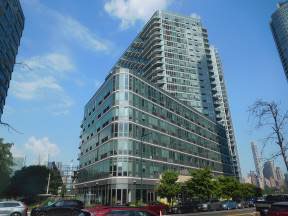
NEW YORK CITY—The Alliance for Downtown Manhattan yesterday released its annual real estate year in review. The report concluded Lower Manhattan enjoyed a banner year in 2017 with a 16-year high in private sector employment with 242,000 jobs, and the highest level of commercial leasing since 2014. John Jordan will have a complete GlobeSt.com report on the study's findings in our afternoon online posting.
In addition, the MNS Manhattan rental market report for Jan. 2018 recorded the most expensive non-doorman, studio, one- and two-bedroom apartments were in the Financial District and TriBeca, ranging in average from $3,261 to $7,788 for monthly rents. Manhattan's most expensive doorman studio, one- and two-bedroom properties were all in SoHo, ranging in average from $4,398 to $8,519.
In this economic context, what should be the policies in rent regulation of the housing stock in Downtown Manhattan?
The New York State Real Property Tax Law section 421-g was enacted in 1995. Letitia James, the city's public advocate noted this was to revitalize Lower Manhattan. At the time nearly 25% of the district's building space lay vacant. With tax abatements, energy rebates, and financial incentives, the city helped developers convert commercial buildings into apartments subject to rent stabilization.
More than 40 tenants at 50 Murray St., a building owned by Clipper Equity, sued the landlord in the case Kuzmich v. 50 Murray Street Acquisition LLC. They claimed the building was wrongfully deregulated and charged market rate rents when the apartments should have still been subject to rent stabilization.
James filed an amicus brief in support of the tenants who received sudden rent increases on their rent stabilized apartments. Her office says that 421-g gave developers tax breaks as incentives to create and maintain critical affordable housing. In July 2017, Judge Carol Edmead ruled in the tenants' favor. A special referee was to be assigned to determine the overcharges, costs and attorneys' fees incurred by the tenants.
Politicians including Manhattan Borough president Gale Brewer, state senator Daniel Squadron and New York City Council member Margaret Chin applauded the public advocate's position and the court's decision. They criticized the landlord's receipt of 421-g tax breaks while removing units from rent stabilization using high rent decontrol.

The owner appealed the case. Luise Barrack is the managing member of Rosenberg & Estis, the law firm which filed an amicus brief representing the Real Estate Board of New York in support of the owners. She tells GlobeSt.com that the crux of the argument was that the 421-g benefits which applied to Lower Manhattan differ from the 421-a affordable housing program.
The appellate division sided with the defendant and on Jan. 18, 2018 reversed the decision of the lower court.
The higher court noted that 421-g buildings are subject to rent stabilization the entire period the building is receiving 421-g benefits. However, 421-g buildings are subject to the luxury vacancy decontrol provisions of the rent stabilization law, unlike buildings that receive tax benefits from Real Property Tax Law sections 421-a and 489.
When an apartment leases at a certain rental amount it can be luxury deregulated. “You can luxury deregulate an apartment when somebody moves into an apartment that is over the luxury deregulation threshold and that threshold keeps increasing over time,” says Barrack. It was $2,000, then $2,500 and subsequently $2,700. As of Jan. 1, 2018, the amount of monthly rent to allow deregulation, currently is $2,700 plus 1.25%, totaling $2,733.75.
If you move into an apartment priced at these levels, you are exempt from rent stabilization. “The idea is you are wealthy enough. You should be paying market rent,” says Barrack. There can also be high income luxury deregulation.
Regarding 50 Murray St., Barrack characterizes the issue as one of luxury deregulation, not affordable housing. She says the rents the tenants were paying were for luxury apartments over the deregulation thresholds. Current listings on StreetEasy for people to now move into the building range from a one-bedroom for $3,800 to a two-bedroom for $4,995.
“This is not necessarily a citywide ruling and that is because this program 421-g was really enacted specifically to deal with Lower Manhattan,” says Barrack. “But anyone in Lower Manhattan that previously received 421-g benefits is certainly going to reap benefits of the law.”
There are thousands of rent stabilized apartments as a result of 421-g, all in Lower Manhattan. As developers continue to expand into the value-add market, this decision touches upon issues of housing stock and the rental prices of who can live in Manhattan.
A spokesperson from the public advocate's office emphasized to GlobeSt.com, “This was not about deregulating luxury apartments. It was a building with residents who lived in rent-stabilized apartments through 421-g.”
Barrack acknowledges the tension in New York City regarding the cost of housing. Studies indicate as much as half of the city's renters are cost-burdened by spending two-thirds of their income on rent. But she says that is not what this case is about.
Want to continue reading?
Become a Free ALM Digital Reader.
Once you are an ALM Digital Member, you’ll receive:
- Breaking commercial real estate news and analysis, on-site and via our newsletters and custom alerts
- Educational webcasts, white papers, and ebooks from industry thought leaders
- Critical coverage of the property casualty insurance and financial advisory markets on our other ALM sites, PropertyCasualty360 and ThinkAdvisor
Already have an account? Sign In Now
*May exclude premium content© 2024 ALM Global, LLC, All Rights Reserved. Request academic re-use from www.copyright.com. All other uses, submit a request to [email protected]. For more information visit Asset & Logo Licensing.








